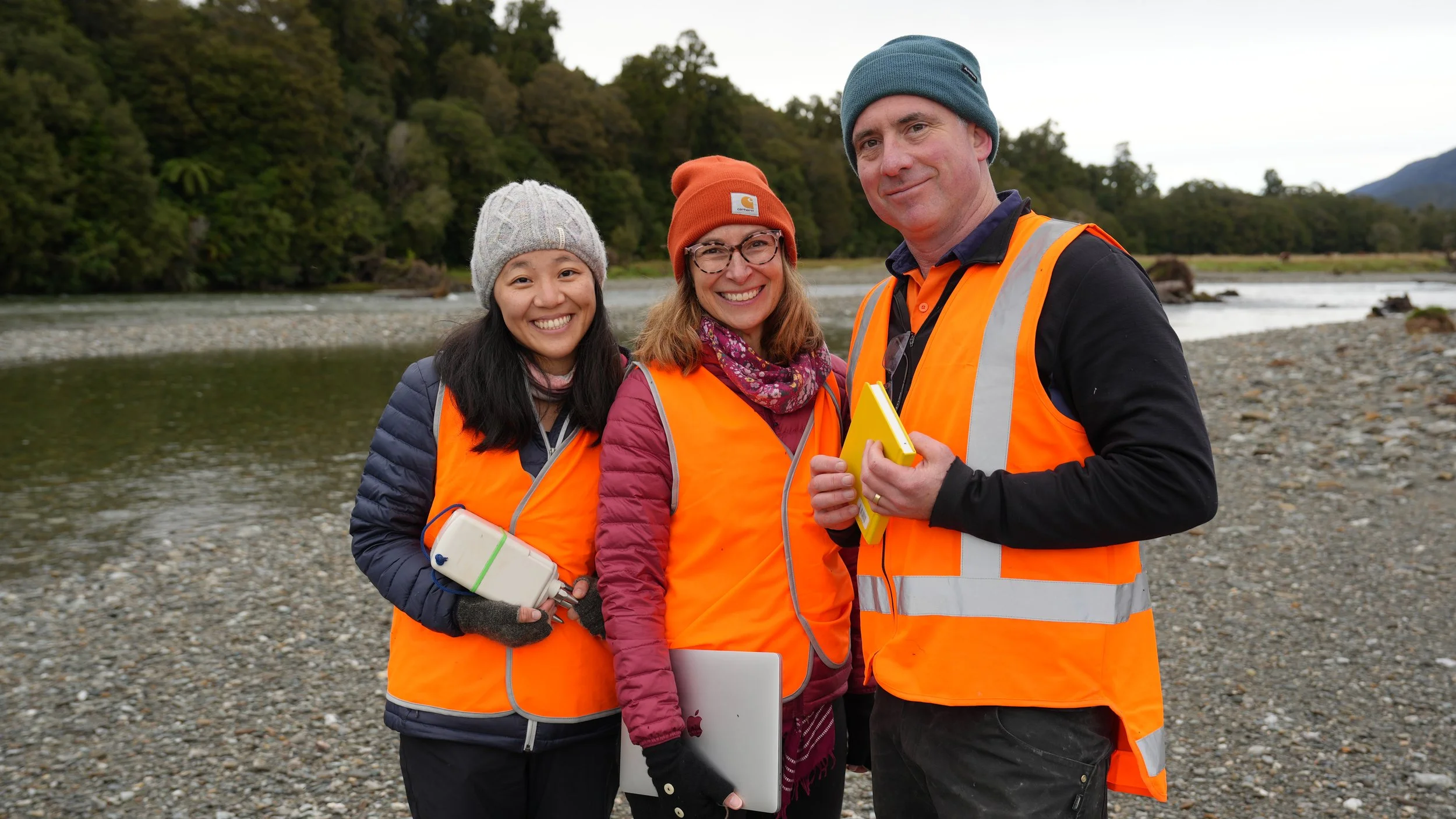Listening to faults: DAS and dark fibres
Dr Voon Hui Lai, Professor Meghan Miller and Professor John Townend. Image: Rory O’Sullivan, Chorus
Dark fibre is currently lighting up beneath Aotearoa, generating new insight into New Zealand’s Alpine fault. Scientists from the Research School of Earth Sciences (RSES) at the Australian National University and Victoria University of Wellington, in collaboration with Chorus, New Zealand's leading broadband provider, are using NCRIS-enabled instrumentation to tap into the country’s telecommunication network to capture seismic data in new detail.
Haast - at the boundary of the Australian and Pacific plates
Seismologists from the Australian National University (ANU) and Victoria University of Wellington (VUW) have deployed AuScope-enabled equipment to monitor rumbles and shakes via dark telecommunication fibre cables. This equipment is strategically positioned in Haast, a remote village on New Zealand's South Island, where the fibres both cross and run parallel to the Alpine Fault.
View towards Mt. Hooker. Image: Rory O’Sullivan, Chorus
Capturing the next earthquake
The Alpine Fault is the most significant seismic hazard on the South Island. Geological studies have determined that it produces large earthquakes of 7-8 magnitude roughly every 300 years. The last earthquake occurred in 1717 AD. This all points to the possibility of a major earthquake occurring in this region in the near future.
To better understand how the Alpine Fault may rupture and how the ground will shake, the team from ANU and VUW are aiming to determine the internal structure of the Alpine Fault in fine detail using data that requires densely spaced sensors.
Explore the Alpine Fault. Source: Meghan Miller
Capturing movement as light
To gather this data, the team is recording changes in the optical properties of backscattered light using distributed acoustic sensing within a fibre optic cable. The DAS interrogator sends laser pulses along "dark fibre," or unused fibre thread, within a buried telecommunication cable. As the fibre deforms in response to earthquakes or other ground shaking, the interrogator captures the changes in the shape of the cable at thousands of points along the fibre.
These backscattered light pulses are captured and stored at very high frequencies at length scales of a few metres, ultimately generating an extensive dataset of approximately one terabyte of data per day, which results in orders of magnitude more data than those collected by an array of traditional seismometers.
”As far as we know, this is the first DAS experiment directly across a major plate boundary. This is an unprecedented opportunity. We can't predict earthquakes, but we can prepare for them. So this is one of the better ways to prepare for them and to understand how faults work.”
– Professor Meghan Miller of the Australian National University.
Professor Meghan Miller discussing the DAS research project. Image: Rory O’Sullivan, Chorus
Revolutionising Geophysical Research
This research marks the most extensive geophysical investigation of the Alpine Fault to date, thanks to the innovative use of Chorus' broadband fibre network.
"Scientists working on different fault lines are going to be very interested in the results," says Dr Voon Hui Lai, a seismologist and postdoctoral research fellow at RSES. "We are also hoping the government will incorporate our findings into their hazard mapping and help New Zealand be better prepared for earthquakes along the Alpine Fault."
Dr Voon Hui Lai explains how DAS works. Source: Rory O’Sullivan, Chorus
Real-world impact
The positive impact of this research extends far beyond the scientific understanding of the fault and its tectonic environment. These data and the models that will result from them will allow for more informed decisions that will enhance preparedness and improve disaster management strategies.
"The real excitement will be to dive into the enormous collection of fibre-optic measurements and pull out signals we don't know about," – John Townend, Professor of Geophysics at Victoria University of Wellington – Te Herenga Waka.
Discover the Haast research hut and DAS in action. Source: Rory O’Sullivan, Chorus
Project Timeline
The fieldwork portion of the project began in February 2023 and finished in November 2023. In October 2023, 24 nodal seismometers were also deployed in an array near the fibre optic cable within the fault zone. These complementary passive seismic instruments will record local earthquakes and be used to image the detailed structure of this part of the Alpine Fault. Over time, data will be collected and stored at AusPass. The DAS data will be located at NCI as part of the Geophysics 2030 project.
Acknowledgements
This project is funded by ARC Future Fellowship (FT210100440) and Catalyst Fund Seeding from the Royal Society Te Apārangi (23-VUW-018-CSG).
STORY IN A NUTSHELL
NCRIS enabled DAS equipment measures seismic activity along New Zealand’s Alpine fault.
AUTHORS
Professor Meghan Miller, Australian National University
Philomena Manifold, AuScope
FURTHER READING
Seismology at light speed: how fibre-optic telecommunications cables deliver a close-up view of NZ's Alpine Fault, The Conversation
AusPass: the Australian Passive Seismic Server
National Collaborative Research Infrastructure Strategy (NCRIS)


